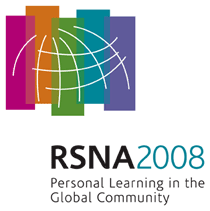
Abstract Archives of the RSNA, 2008
Gerd Melkus Dipl Phys, Abstract Co-Author: Nothing to Disclose
José Raya MSc, Presenter: Nothing to Disclose
Olaf Dietrich, Abstract Co-Author: Nothing to Disclose
Elisabeth Muetzel MD, Abstract Co-Author: Nothing to Disclose
Eva Gruber, Abstract Co-Author: Nothing to Disclose
Lucianna Filidoro Dipl Phys, Abstract Co-Author: Nothing to Disclose
Maximilian F. Reiser MD, Abstract Co-Author: Nothing to Disclose
Peter Michael Jakob PhD, Abstract Co-Author: Nothing to Disclose
Christian Glaser MD, Abstract Co-Author: Nothing to Disclose
et al, Abstract Co-Author: Nothing to Disclose
Articular cartilage (AC) plays an important role in the pathogenesis of osteoarthritis (OA). In AC the T2 relaxation time is sensitive to alterations of the cartilage matrix. The apparent diffusion coefficient (ADC), and the fractional anisotropy (FA) of diffusion are influenced by the collagen matrix and the proteoglycan content. The native T1 relaxation time seems to correlate to cartilage mechanical properties, and the water content (WC) is known to increase in OA. The purpose of this work was to characterize healthy and diseased articular cartilage at 17.6T with a multiparametric (T2, T1, WC and DTI) analysis.
Healthy (n=17, 30±11y), severe OA (n=5, 54±17y) and moderate OA (n=7, 63±14y) excised human patellar cartilage samples harvested 24 hours after death were examined on a 17.6T MRI scanner. MRI protocols include a multiecho multislice SE sequence (T2), a saturation-recovery FLASH sequence (T1), a diffusion-weighted SE sequence (DTI) and a FLASH sequence (B1), all sequences having a FOV of (12.8mm)², a resolution of 50×100µm² and slice thickness of 0.8mm. Values of T2, T1, WC, ADC and FA were calculated in each cartilage region (radial (RZ), transitional (TRZ), and tangential (TGZ) zone). The distribution of T2, T1, WC, ADC and FA from the bone cartilage interface (BCI) to the articular surface (AS) was calculated.
In healthy AC the RZ is characterized by low constant T2, slowly increasing ADC, WC and T1, and a rapidly decaying FA. In the TRZ, T2 reaches a maximum, whereas ADC, WC and T1 remain constant. The TGZ is clearly identifiable by a decrease of T2 and WC and an increase of FA, ADC, and T1. Interestingly in healthy cartilage T1 and ADC showed a very similar behavior.
The progression of OA leads to a broadening of the TRZ (depicted by high T2) with complete loss of the TGZ in severe OA, accompanied by an increase of ADC and T1 and a reduction of FA. In the RZ, all parameters remain unaltered. The WC increases in the TGZ with OA ((83±13)% healthy, (91±8)% OA). Global WC varied from (74±5)% in healthy to (80±2)% in severe OA.
The results are compatible with decreased anisotropy in the collagen network and reduced PG content in OA.
A multiparametric study of AC contribute to gain insight into the mechanism of pathology as well as to clarify factors influencing the MRI parameters.
Melkus, G,
Raya, J,
Dietrich, O,
Muetzel, E,
Gruber, E,
Filidoro, L,
Reiser, M,
Jakob, P,
Glaser, C,
et al, ,
Multiparametric Characterization of Healthy and Diseased Articular Cartilage at 17.6 T. Radiological Society of North America 2008 Scientific Assembly and Annual Meeting, February 18 - February 20, 2008 ,Chicago IL.
http://archive.rsna.org/2008/6021774.html

